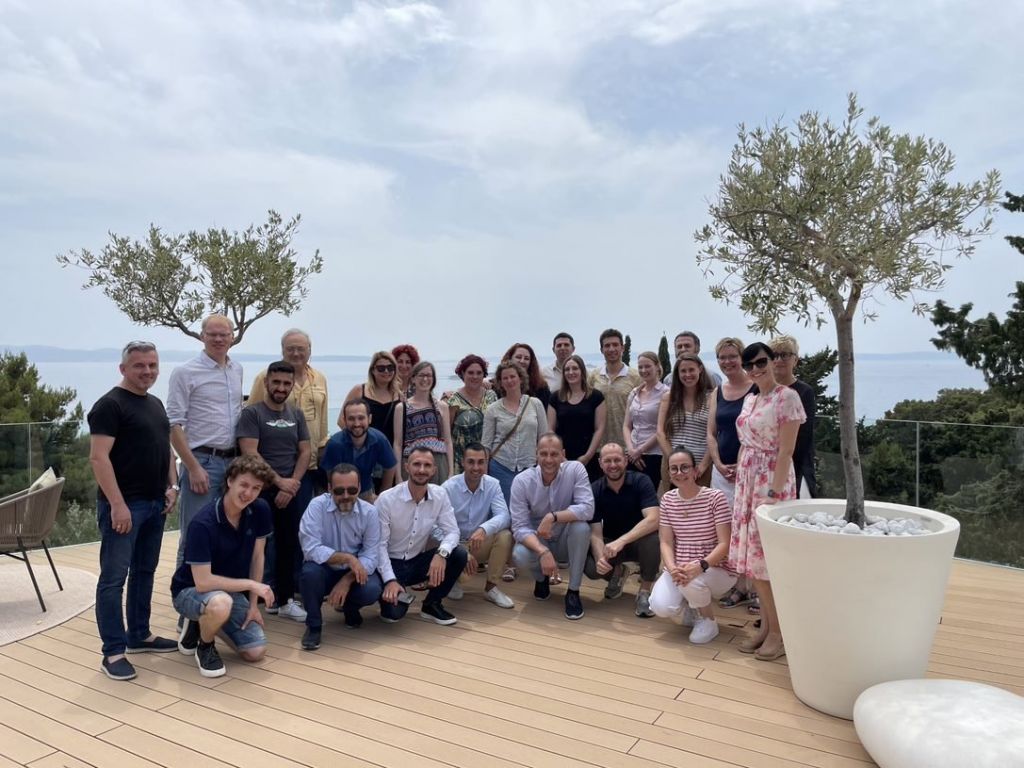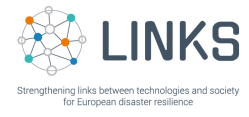
The results generated in the LINKS project aim to provide unique value for different target groups:
- Practitioners: LINKS offers guidance on how to integrate social media and crowdsourcing into the disaster management activities of practitioners in the most effective ways with respect to technologies and planning.
- Policy and Decision Makers: LINKS provides them with a set of concrete recommendations capturing the formal and informal standards, procedures and guidelines across Disaster Management Organizations for applying social media and crowdsourcing in disasters
- Researchers: LINKS provides them a multidisciplinary methodology to study disaster risk governance by looking at social media and crowdsourcing in crisis across social, institutional, and technical dimensions
- Civil Society: The application of the LINKS results allows civil society to be more prepared to face disaster scenarios, enhancing the resilience of the local communities
- Businesses: The use of the LINKS results allows businesses to better understand the market and to realise products tailored to the needs of practitioners and take into account the aspects of (citizens) inclusion.
In order to reach these objectives, in the second year of the project, many activities have been implemented by the LINKS Consortium to promote our results. This allowed us to strengthen the relationships with our target groups and with relevant networks and projects. Below is a short overview of the most important initiatives.
Practitioners represent one of the most important target groups of LINKS. Many of the LINKS results will be directly tested and eventually used by them. The General Councils organised by FEU – Federation of the European Union Fire Officer Associations in September and in May 2021 have represented a good opportunity to not only to present our results to practitioners, but also to validate them. Moreover, the participation of SIC – Safety Innovation Center in the EENA – European Emergency Number Association Annual Conference in April 2022, was an important occasion to meet European professionals from across the public safety field (here and here you can find all the materials of the session “Strengthening the engagement of civil society”). As was their participation in the Annual symposium of the Association for the Promotion of German Fire Protection and in the Social Media and Crowdsourcing workshop for the special forces of the police, both in May 2022, and in a “safety camp” event in April 2022, which provided opportunities to present and validate the requirements of LINKS result, such as the Social Media and Crowdsourcing Technologies Library. During the 3rd Digital Week of the DGSMTech, in November 2021, we also presented the benefits of the LINKS Community Center (LCC) to experts in civil protection.
Vrije Universiteit Amsterdam (VU) participated in a workshop on Social Media for Disaster Risk Management: Researchers meet Practitioners in June (here you can find the related materials), organized by the DRMKC – Disaster Risk Management Knowledge Center. We presented an early version of the LINKS Framework, focusing on how the strategic planning entry point may be of added value for practitioners. Moreover, their participation in the Io non rischio event, organised by the Italian Civil Protection Agency in October 2021 (here you can find the recorded session) allowed LINKS to discuss how social media and crowdsourcing contribute to better understanding disaster risks and implications on citizens’ lives both with relevant practitioners and with the overall civil society. Specifically, our focus was on how social media can be an added value only if there is trust between the government and/or first responders and the civil society. Contrariwise it can turn into a major challenge if, for instance, there is a lack of trust and knowledge of how citizens perceive risks. This entails that risk and crisis communication should not take place only during crises, but that institutions and citizens alike should be prepared and this can only be done in “peacetime”. Additionally, communication must be targeted and tailored to information needs.
Another relevant target group for LINKS is represented by policy and decision makers. In this regard, LINKS has been presented in March 2022 at the CERIS – Community for European Research and Innovation for Security, together with all the DRS-01 Cluster projects. University of Copenhagen (UCPH) discussed how social media and crowdsourcing can be applied in disaster risk management processes. Resilience has been presented as a concept consisting of 3 different components: systems, Institutions, and individuals, which requires the implementation of a shifting mechanism for communication between authorities and citizens. Discussing on how social media and crowdsourcing can integrate citizens and vulnerable groups in disaster management processes, Save the Children Italia focused on the importance of considering diversity as a real added value. Creating participatory processes, for example in schools with children, allows to better consider the needs of vulnerable groups.
Moreover, LINKS has been presented, along with the projects belonging to the DRS-01 Cluster (RESILOC, BuildERS, ENGAGE) during the European Forum for Disaster Risk Reduction 2021, organised by the United Nations for Disaster Risk Reduction in November 2021. The DRS-01 Cluster hosted a hybrid session titled “Strengthening disaster risk governance at local level: enhancing information exchanges through new technologies and assessment models”, during which they explained their approaches to accelerating the implementation of Sendai Framework for disaster risk reduction in Europe (here you can find our contribution). The event was attended by more than 60 participants (decision makers, representatives from civil society organizations, researchers, etc.), and engaged participants in an interactive session. During the interactive workshop session, we involve the participants in discussing how social media can help during disasters, by facing two main issues: the challenges in using social media in different disaster management phases and the capacities to better use social media to engage with citizens during disasters.
The United Nations for Disaster Risk Reduction’s initiatives, in particular the International Day for Disaster Risk Reduction 2021 (held in October) allowed us to disseminate how LINKS results contribute to the United Nations for Disaster Risk Reduction’s objectives. The Twitter campaign LINKS carried out during the International Day for Disaster Risk Reduction has been dedicated in particular to the centrality of people in disaster management processes (with the intention to provide credible information and to focus on vulnerability) and gained high attention from experts and projects in the disaster risk reduction field.
As already emphasised, LINKS has been organising many initiatives with the other H2020 projects that are part of the DRS-01 Cluster. In addition to those already mentioned, we already took part in specific events organised by these projects. For example, in June EOS – European Organisation for Security and UNIFI – University of Firenze took part in the 1st Awareness Workshop organised by RiskPACC and in April 2022 in the ENGAGE Conference, Safety Innovation Center discussed about the potential utility of the SMCS Technology Library.
In the research community, the work of LINKS has been presented during conferences dedicated to disaster studies, with a particular focus on the social dimension. In July 2022 University of Firenze presented the work entitled “The coast isn’t clear: climate justice implications of communicating urban flood risk in affluent vulnerable communities” as part of the special event “Climate justice in future cities: geographical perspectives for inclusive urban resilience and adaptation” of the Smart and Sustainable Planning for Cities and Regions. They also presented the work “Alternative or complementary? A critical mapping of the practices of crowdsourcing to respond to emergencies in Italy”’ during the scientific conference Geography and Technology organized by Società di Studi Geografici. In September 2021 University of Copenhagen presented the contribution “Social media and crowdsourcing use in disaster governance: Examining interactions between public authorities and citizens for improved disaster risk management” during the ESA – European Sociological Association Conference 2021, by focusing on our results related to using social media and crowdsourcing in disaster governance (interactions between public authorities and citizens). In talking about research networks it is useful also to note that academic partners in LINKS have been conducting training activities with the students, not only with the aim of disseminating key concepts of the project (e.g.: resilience, SMCS in crisis situations, disaster management processes, digital transformation processes, etc.), but also to actively involve them in some tasks of the project.
The participation in communication events has represented the occasion to open the LINKS results to the wider audience represented by the civil society. In a dedicated article within this Newsletter we emphasize the central role of the LINKS Community Workshops (LCW) with this aim. This format represents a good opportunity to engage local stakeholders in the different LINKS Cases and collect needs and experiences on the specific disaster scenarios. Additionally, workshops, especially conducted by the University of Florence, Save the Children Italy and Link Campus University allowed us to engage with minors around disaster prevention and discuss with them about the uses and potentials of digital technologies in emergency management. A different format, the Smart City Challenge Hackathon, held in October 2021, was conducted by Københavns Professionshøjskole and the Frederiksberg Kommune in order to involve citizens in discussing how social media can help communication between public authorities, first responders and citizens to improve warnings, public awareness, engagement and preparedness before, during and after cloudburst flooding. The final output has been the prototype of a mobile application.
LINKS also engaged with businesses working with the implementation of digital solutions in the context of social media and crowdsourcing technologies. Our participation in the Accessibility Days 2022 in May 2022 with the workshop “Progettare soluzioni interattive inclusive per la comunicazione in situazioni di emergenza” allowed us to involve experts in the field of accessibility to analyse accessibility and inclusivity of applications used for communication during emergencies, in order to identify some elements and understanding on how to build more inclusive interactive solutions. The results of this workshop have contributed to the refinement of the LINKS activities on disaster risk perception and vulnerability.
LINKS also closed out the second year with the first in-person consortium meeting since the project began. A welcomed event after the conditions around the pandemic. The meeting was held in Croatia, where the chair of our associated partner the Disaster Preparedness and Prevention Initiative for South Eastern Europe (DPPI SEE), is currently seated. The two day meeting included a series of workshops where we had the opportunity to discuss local experiences around risk communication and crowdsourcing, and test some LINKS results, together with DPPI SEE members working in disaster management from more than 10 member states.
Looking forward LINKS is excited to be taking part in a number of events and activities in the last half of 2022. Some of the most interesting on the agenda include a co-hosted workshop with our sister project RESILOC in Copenhagen in November, which will aim at bringing DRM stakeholders together from the Nordic and Italian regions to discuss and validate project results. The workshop will be followed by a joint panel at the NEEDS conference, where will be discussing the intricacies of citizen involvement in the work of EU civil protection, given the ever changing risk landscape. And in November LINKS will be presenting at the follow up event to the CERIS meeting in March, together with the DRS-01 cluster projects.

